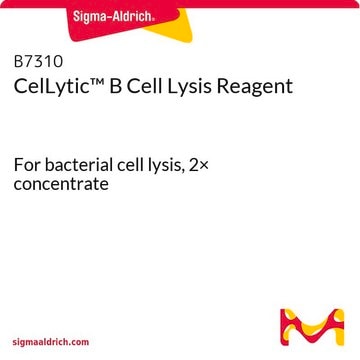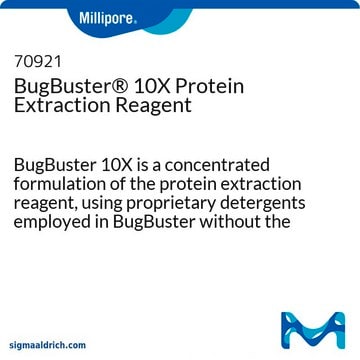C8740
CelLytic™ B Cell Lysis Reagent
For bacterial cell lysis, 10× concentrate
Synonym(s):
bacterial cell lysis reagent
Sign Into View Organizational & Contract Pricing
All Photos(1)
About This Item
Recommended Products
form
liquid
Looking for similar products? Visit Product Comparison Guide
Application
TM[="CelLytic"] B Cell Lysis Reagent has been used for lysing E.coli 5-helix bundle protein. It is also suitable for lysing hepatitis B X-interacting protein (HBXIP) and E. coli TG1 cells.
A proprietary, non-denaturing formulation of zwitterionic detergents used for the lysis of bacterial cells and extraction of recombinant proteins.
Features and Benefits
- Higher protein extraction efficiency than traditional methods such as sonication and lysozyme
- Scalable for 1 to 25 grams of bacterial cell paste
- No interference with downstream applications such as affinity chromatography, IP, and Western blotting
- Compatible with protease inhibitors, inhibitor cocktails, chaotropes, salts, chelating agents and reducing agents
Other Notes
10X concentrate of detergent blend contains no buffering components, giving the researcher flexibility to integrate the lysis reagent into their desired system. Also amenable to automation protocols for recombinant protein extraction and purification.
Legal Information
Covered by US Patent No 7,282,475 B2 and are sold for research use only. Commercial use requires addtional licenses.
CelLytic is a trademark of Sigma-Aldrich Co. LLC
Signal Word
Warning
Hazard Statements
Precautionary Statements
Hazard Classifications
Eye Irrit. 2 - Skin Irrit. 2
Storage Class Code
12 - Non Combustible Liquids
WGK
WGK 3
Flash Point(F)
Not applicable
Flash Point(C)
Not applicable
Personal Protective Equipment
dust mask type N95 (US), Eyeshields, Gloves
Certificates of Analysis (COA)
Search for Certificates of Analysis (COA) by entering the products Lot/Batch Number. Lot and Batch Numbers can be found on a product’s label following the words ‘Lot’ or ‘Batch’.
Already Own This Product?
Find documentation for the products that you have recently purchased in the Document Library.
Customers Also Viewed
A highly efficient procedure for the extraction of soluble proteins from bacterial cells with mild chaotropic solutions
Danilevich VN, et al.
Chemical Engineering & Technology, 31(6), 904-910 (2008)
Interaction of hepatitis B viral oncoprotein with cellular target HBXIP dysregulates centrosome dynamics and mitotic spindle formation
Wen Y, et al.
The Journal of biological chemistry, 283(5), 2793-2803 (2008)
A fluorescence polarization assay using an engineered human respiratory syncytial virus F protein as a direct screening platform
Park M, et al.
Analytical Biochemistry, 409(2), 195-201 (2011)
Yihong Guan et al.
Communications biology, 3(1), 493-493 (2020-09-09)
Loss-of-function TET2 mutations (TET2MT) are common in myeloid neoplasia. TET2, a DNA dioxygenase, requires 2-oxoglutarate and Fe(II) to oxidize 5-methylcytosine. TET2MT thus result in hypermethylation and transcriptional repression. Ascorbic acid (AA) increases dioxygenase activity by facilitating Fe(III)/Fe(II) redox reaction and
Our team of scientists has experience in all areas of research including Life Science, Material Science, Chemical Synthesis, Chromatography, Analytical and many others.
Contact Technical Service















